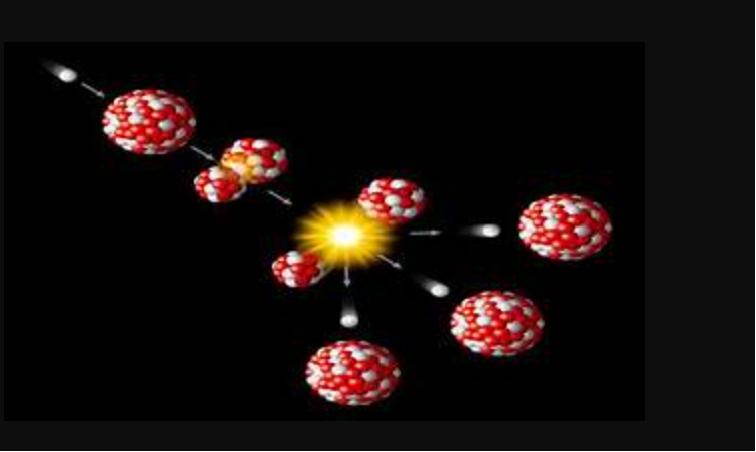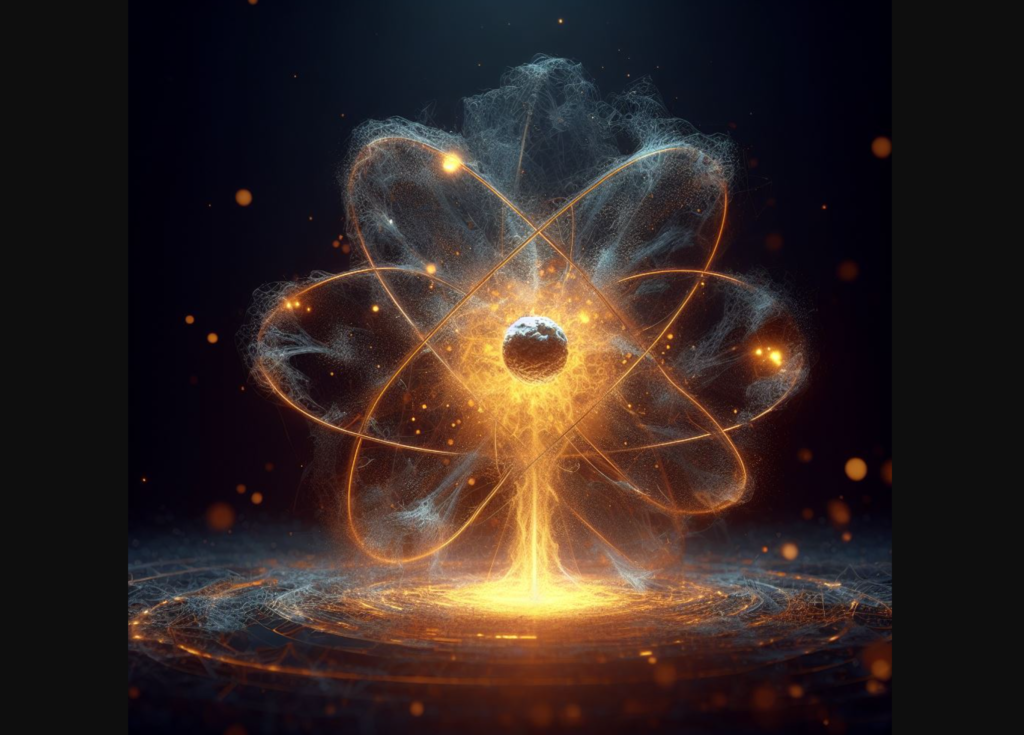Nuclear reactions are processes that involve the transformation of atomic nuclei, the core of atoms that contain protons and neutrons. Nuclear reactions can release or absorb large amounts of energy and change the identity of the elements involved. Nuclear reactions are different from chemical reactions, which involve the rearrangement of atoms in molecules without altering their nuclei.
Most of the physical processes that take place in our bodies are chemical reactions, such as the metabolism of food, the synthesis of proteins, and the replication of DNA. However, there are also some nuclear reactions that occur in our bodies, although they are very few and weak compared to the chemical reactions. These nuclear reactions do not affect our bodies much, but they are interesting to explore.
Types of nuclear reactions
There are three main types of nuclear reactions: nuclear fusion, nuclear fission, and radioactive decay.

Nuclear reactions
Also read : The Colorless Beauty Of The Atom: Exploring The Visual World Of Subatomic Particles
- Nuclear fusion is the joining of two small atomic nuclei into one larger nucleus. This process releases a lot of energy and is the source of power for stars like the sun. Nuclear fusion requires very high temperatures and pressures to overcome the repulsion between the positively charged nuclei. Therefore, nuclear fusion does not happen in our bodies, as they are too cold and low-pressure for this reaction to occur.
- Nuclear fission is the splitting of one large atomic nucleus into two or more smaller fragments. This process also releases a lot of energy and is the basis of nuclear power plants and nuclear bombs. Nuclear fission requires either a large mass of heavy, radioactive elements (such as uranium) or a high-energy particle (such as a neutron) to initiate the reaction. Therefore, nuclear fission does not happen in our bodies either, as they do not contain enough heavy elements or high-energy particles for this reaction to occur.
- Radioactive decay is the change of one unstable nucleus into a more stable one. This process may release or absorb some energy and may change the number of protons and neutrons in the nucleus. Radioactive decay happens spontaneously and randomly to nuclei that are not stable, meaning that they have either too many or too few neutrons, or that they are simply too large. Radioactive decay is the most common type of nuclear reaction that occurs in our bodies, as we have some atoms that are naturally radioactive or that become radioactive due to external sources.

Nuclear reactions
Sources of radioactivity in our bodies
Radioactivity is the emission of energetic particles or rays from the nuclei of atoms. Radioactivity can be measured by the amount of radiation emitted per unit time, which is called the activity. The activity of a radioactive substance depends on the number of atoms, the type of decay, and the half-life of the substance. The half-life is the time it takes for half of the atoms to decay.
There are two main sources of radioactivity in our bodies: natural and artificial.

Nuclear reactions
- Natural radioactivity comes from the elements that are present in our bodies or in the environment. Some of these elements are naturally radioactive, such as potassium-40, carbon-14, and uranium-238. Others are stable, but can become radioactive when exposed to cosmic rays, such as nitrogen-14 and oxygen-16. The most abundant radioactive element in our bodies is potassium-40, which accounts for about 98% of our natural radioactivity1. Potassium-40 has a half-life of 1.25 billion years and decays by emitting a beta particle (an electron) and a gamma ray. Potassium-40 is essential for our health, as it is involved in nerve and muscle function, fluid balance, and blood pressure regulation. The average human body contains about 140 grams of potassium, of which 0.012% is potassium-40. This means that we have about 4,400 atoms of potassium-40 decaying in our bodies every second, producing an activity of about 4,000 becquerels (Bq). A becquerel is the unit of radioactivity and corresponds to one decay per second. To put this in perspective, a banana contains about 0.1 Bq of potassium-40, and a smoke detector contains about 30,000 Bq of americium-2412.
- Artificial radioactivity comes from the exposure to man-made sources of radiation, such as medical procedures, nuclear accidents, or weapons testing. Some of these sources introduce radioactive elements into our bodies, such as iodine-131, cesium-137, or plutonium-239. Others produce radiation that can interact with our atoms and make them radioactive, such as x-rays, gamma rays, or neutrons. The amount of artificial radioactivity in our bodies depends on the type, dose, and duration of exposure, as well as the clearance rate of the radioactive elements. For example, iodine-131 has a half-life of 8 days and is mainly absorbed by the thyroid gland, where it can cause cancer or other disorders. Cesium-137 has a half-life of 30 years and is distributed throughout the body, where it can cause various health problems. Plutonium-239 has a half-life of 24,000 years and is mostly deposited in the bones, where it can cause leukemia or bone cancer. The average human body contains about 0.1 Bq of artificial radioactivity, but this can vary widely depending on the individual’s history and location3.
Effects of radioactivity on our bodies
Radioactivity can have both beneficial and harmful effects on our bodies, depending on the type, amount, and duration of exposure.

- Beneficial effects of radioactivity are mainly related to its use in medicine, such as diagnosis, treatment, or research. Radioactive elements can be used as tracers to monitor the function of organs, tissues, or cells, or to detect diseases or abnormalities. For example, iodine-123 can be used to image the thyroid gland, technetium-99m can be used to image the heart or the brain, and fluorine-18 can be used to image tumors or infections. Radioactive elements can also be used as therapy to kill cancer cells or to treat other conditions. For example, iodine-131 can be used to treat hyperthyroidism or thyroid cancer, phosphorus-32 can be used to treat polycythemia or leukemia, and radium-223 can be used to treat bone metastases. Radioactive elements can also be used as research tools to study the effects of radiation on biological systems, or to develop new drugs or techniques. For example, carbon-14 can be used to label molecules or to measure the age of organic materials, and cobalt-60 can be used to

Conclusion
Nuclear reactions are processes that involve the transformation of atomic nuclei. There are three main types of nuclear reactions: nuclear fusion, nuclear fission, and radioactive decay. Nuclear fusion and nuclear fission require very high energy or mass to occur, and they do not happen in our bodies. Radioactive decay happens spontaneously and randomly to unstable nuclei, and it can happen in our bodies. However, the radioactive decay in our bodies is very rare and weak, and it does not affect our bodies much. The main sources of radioactive decay in our bodies are carbon-14, hydrogen-3, potassium-40, and phosphorus-32, which are present in very small amounts and have long half-lives. The radioactive decay in our bodies results in about 11,000 decays per second, which is negligible compared to the billions of chemical reactions that take place in our cells every second. Therefore, we can say that there are nuclear reactions going on in our bodies, but they are not very important for our life.
Also read : Double Entanglement: A Glimpse Into Quantum Physics’ Intriguing Phenomenon




































